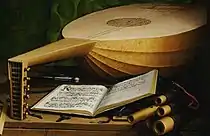The Ambassadors (Holbein)
The Ambassadors is a 1533 painting by Hans Holbein the Younger.
| The Ambassadors | |
|---|---|
 | |
| Artist | Hans Holbein the Younger |
| Year | 1533 |
| Medium | Oil on oak |
| Dimensions | 207 cm × 209.5 cm (81 in × 82.5 in) |
| Location | National Gallery, London |
Also known as Jean de Dinteville and Georges de Selve,[1] after the two people it portrays, it was created in the Tudor period, in the same year Elizabeth I was born. Franny Moyle speculates that Elizabeth's mother, Anne Boleyn, then Queen of England, might have commissioned it as a gift for Jean de Dinteville, the ambassador portrayed on the left.[2]
As well as being a double portrait, the painting contains a still life of meticulously rendered objects, the meaning of which is the cause of much debate. It incorporates one of the best-known examples of anamorphosis in painting. The Ambassadors has been part of London's National Gallery collection since its purchase in 1890.
Description
Though he was a German-born artist who spent much of his time in England, Holbein here displays the influence of Early Netherlandish painting. He used oils which for panel paintings had been developed a century before in Early Netherlandish painting, and just as Jan van Eyck and the Master of Flémalle used extensive imagery to link their subjects to religious concepts, Holbein used symbolic objects around the figures to suggest mostly secular ideas and interests.

Among the clues to the figures' associations are a selection of scientific instruments including two globes (one terrestrial and one celestial), a shepherd's dial, a quadrant, a torquetum, and a polyhedral sundial,[3] as well as various textiles including the floor mosaic, based on a design from Westminster Abbey (the Cosmati pavement, before the High Altar), and the carpet on the upper shelf, an example of Oriental carpets in Renaissance painting. The figure on the left is in secular attire while the figure on the right is dressed in clerical clothes. They flank the table, which displays open books and symbols of religious knowledge, including a symbolic link to the Virgin. Near the top left corner, a crucifix can be seen, partially covered by the curtain.

In contrast, other scholars have suggested the painting contains overtones of religious strife. The conflicts between secular and religious authorities are here represented by Jean de Dinteville, a landowner, and Georges de Selve, the Bishop of Lavaur. The commonly accepted symbol of discord, a lute with a broken string, is included next to a hymnbook in Martin Luther's translation, suggesting strife between scholars and the clergy.[4] For others, if the lute's broken string suggests the interruption of religious harmony, the Lutheran hymnal, open on facing pages reproducing a song on the Commandments (Law) and one on the Holy Spirit (Grace) may suggest their being in "harmony" with each other.[5]
The terrestrial globe on the lower shelf repeats a portion of a cartographically imaginative map created in possibly 1530 and of unknown origin. The map is referred to as the Ambassadors' Globe due to its popularly known appearance in the painting.[6][7]
The work has been described as "one of the most staggeringly impressive portraits in Renaissance art."[8]
Anamorphic skull
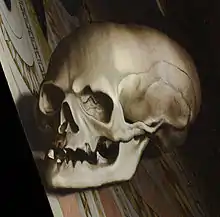
The most notable and famous of Holbein's symbols in the work is the distorted skull which is placed in the bottom centre of the composition. The skull, rendered in anamorphic perspective, another invention of the Early Renaissance, is meant to be a visual puzzle as the viewer must approach the painting from high on the right side, or low on the left side, to see the form as an accurate rendering of a human skull. While the skull is evidently intended as a vanitas or memento mori, it is unclear why Holbein gave it such prominence in this painting. A simple explanation is that "memento mori" was de Dinteville's motto,[9] while another possibility is that this painting represents three levels: the heavens as portrayed by the astrolabe and other objects on the upper shelf, the living world as evidenced by books and a musical instrument on the lower shelf, and death signified by the skull.
It has also been hypothesized that the painting was meant to hang beside a doorway, or even in a stairwell, so that persons entering the room or walking up the stairs and passing the painting on their left would be confronted by the appearance of the skull. A further possibility is that Holbein simply wished to show off his ability with the technique in order to secure future commissions.[10] However, artists often incorporated skulls as a reminder of mortality. Holbein may have intended the skulls (one as a gray slash and the other as a medallion on Jean de Dinteville's hat) and the crucifix in the upper left corner to encourage contemplation of one's impending death and the resurrection.[4]
Identity of the subjects
Before the publication of Mary F. S. Hervey's Holbein's Ambassadors: The Picture and the Men in 1900, the identity of the two figures in the picture had long been a subject of intense debate. In 1890, Sidney Colvin was the first to propose the figure on the left as Jean de Dinteville, Seigneur of Polisy (1504–1555), French ambassador to the court of Henry VIII for most of 1533. Shortly afterwards, the cleaning of the picture revealed that his seat of Polisy is one of only four French places marked on the globe.[11] Hervey identified the man on the right as Georges de Selve (1508/09–1541), Bishop of Lavaur, after tracing the painting's history back to a seventeenth-century manuscript. According to art historian John Rowlands, de Selve is not wearing episcopal robes because he was not consecrated until 1534.[12] De Selve is known from two of de Dinteville's letters to his brother François de Dinteville, Bishop of Auxerre, to have visited London in the spring of 1533. On 23 May, Jean de Dinteville wrote: "Monsieur de Lavaur did me the honour of coming to see me, which was no small pleasure to me. There is no need for the grand maître to hear anything of it". The grand maître in question was Anne de Montmorency, the Marshal of France, a reference that has led some analysts to conclude that de Selve's mission was a secret one; but there is no other evidence to corroborate the theory.[13] On June 4, the ambassador wrote to his brother again, saying: "Monsieur de Lavaur came to see me, but has gone away again".[14]

Hervey's identification of the sitters has remained the standard one, affirmed in extended studies of the painting by Foister, Roy, and Wyld (1997), Zwingenberger (1999), and North (2004), who concludes that "the general coherence of the evidence assembled by Hervey is very satisfying"; however, North also notes that, despite Hervey's research, "Rival speculation did not stop at once and is still not entirely dead".[15] Giles Hudson, for example, has argued that the man on the right is not de Selve, but Jean's brother François, Bishop of Auxerre, a noted patron of the arts with a known interest in mathematical instruments.[16] The identification finds support in the earliest manuscript in which the painting is mentioned, a 1589 inventory of the Chateau of Polisy, discovered by Riccardo Famiglietti. However, scholars have argued that this identification of 1589 was incorrect. John North, for example, remarks that "This was a natural enough supposition to be made by a person with limited local knowledge, since the two brothers lived on the family estates together at the end of their lives, but it is almost certainly mistaken".[17] He points to a letter François de Dinteville wrote to Jean on 28 March 1533, in which he talks of an imminent meeting with the Pope and makes no mention of visiting London. Unlike the man on the right of the picture, François was older than Jean de Dinteville. The inscription on the man on the right's book is "AETAT/IS SV Æ 25" (his age is 25); that on de Dinteville's dagger is "AET. SV Æ/ 29" (he is 29).[18]
North's book analyzes the painting and shows it to be representing Good Friday through various clues on the instruments.[3]
- Scientific and mathematical elements

 Universal equinoctial dial (disassembled, front) and Quadrant (rear)
Universal equinoctial dial (disassembled, front) and Quadrant (rear)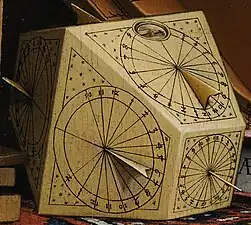
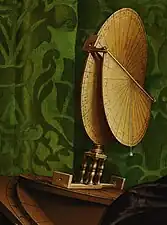
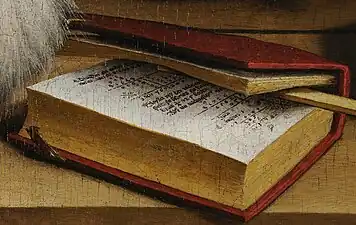 Peter Apian's arithmetic book
Peter Apian's arithmetic book
References
Citations
- "Hans Holbein the Younger The Ambassadors NG1314 National Gallery, London". www.nationalgallery.org.uk. Archived from the original on 24 October 2018. Retrieved 24 October 2018.
- Moyle, Franny, The King's Painter: The Life and Times of Hans Holbein, New York: Abrams Press, 2021, pp. 221-222.
- Dekker & Lippincott 1999
- Mamiya, 675
- Bertoglio, 569
- Pigafetta, Antonio (1994). Magellan's Voyage: a narrative of the first circumnavigation. Dover Publications Inc. p. 30. ISBN 0-486-28099-3.
- Hayes, Derek (2003). Historical Atlas of the Arctic. Douglas & McIntyre Ltd. pp. 8–9. ISBN 1-55365-004-2.
- Welton, J. in Farthing, S., ed. (2011)
- "15 Facts About Hans Holbein's 'The Ambassadors'". Mental Floss. 20 April 2016.
- "Anamorphosis". World Wide Words. 26 November 2011. Archived from the original on 1 September 2012. Retrieved 21 August 2012.
- Rowlands, 139–41.
- Rowlands, 140.
- Foister, Roy, and Wyld, 16.
- Foister, 14.
- North, 7.
- See Hudson, 201–205.
- North, 7; see also, Foister, Roy, and Wyld, p. 102, n.1 under "Provenance."
- Rowlands, 139.
Sources
- Bertoglio, Chiara (2017). Reforming Music. Music and the Religious Reformations of the Sixteenth Century. Berlin: De Gruyter. ISBN 9783110520811.
- Dekker, Elly; Lippincott, Kristen (1999). "The Scientific Instruments in Holbein's Ambassadors: A Re-Examination". Journal of the Warburg and Courtauld Institutes. The Warburg Institute. 62: 93–125. doi:10.2307/751384. ISSN 0075-4390. JSTOR 751384. S2CID 190327018.
- Farthing, Stephen, ed. (2011). 1001 Paintings You Must See Before You Die. London: Cassell. p. 167. ISBN 978-1-84403-704-9.
- Foister, Susan; Roy, Ashok; Wyld, Martin (1997). Holbein's Ambassadors: Making and Meaning. London: National Gallery Publications. ISBN 1-85709-173-6.
- Hart, Vaughan (1999). ‘Hans Holbein’s “The Ambassadors” (1533): A Computer View of Renaissance Perspective Illusion’, Computers and the History of Art, Harwood Academic Publishers, vol.8 no.2, pp. 1–13.
- Hervey, Mary (1900). Holbein's Ambassadors: The Picture and the Men. London: George Bell and Sons.
- Hudson, Giles (April 2003). "The Vanity of the Sciences". Annals of Science. 60 (2): 201–205. doi:10.1080/0003379021000047112. S2CID 144232317.
- Mamiya, Christin J. (2005). Gardner's Art Through the Ages 12th ed. California: Wadsworth/ Thomson Learning, Inc. ISBN 0-15-505090-7.
- Zanchi, Mauro (2013). Holbein, Art e Dossier (in Italian). Firenze: Giunti. ISBN 978-8-80978-250-1.
- North, John (2004). The Ambassadors' Secret: Holbein and the World of the Renaissance. London: Phoenix. ISBN 1-84212-661-X.
- Rowlands, John (1985). Holbein: The Paintings of Hans Holbein the Younger. Boston: David R. Godine. ISBN 0-87923-578-0.
- Zwingenberger, Jeanette (1999). The Shadow of Death in the Work of Hans Holbein the Younger. London: Parkstone Press. ISBN 1-85995-492-8.
External links
 Media related to The Ambassadors (Holbein) at Wikimedia Commons
Media related to The Ambassadors (Holbein) at Wikimedia Commons- Google Art Project HQ scan of the painting
- The Ambassadors, Zoomable and Annotated, with many details
- Video proposing an explanation as to how the anamorphic projection was made
- The National Gallery article on the painting
- Essay on the meaning of the painting
- ArtSleuth : The Ambassadors, Rendezvous with Death
- Holbein's The Ambassadors: unlocking hidden mysteries
- "Holbein's The Ambassadors". Smarthistory at Khan Academy. Archived from the original on 4 March 2013. Retrieved 10 March 2013.
- "HOLBEIN – The Ambassadors". ArtSleuth. Canaleducatif. Archived from the original on 10 March 2016. Retrieved 10 March 2013.
- "Holbein's skull Part I". National Gallery (UK). Archived from the original on 6 May 2014. Retrieved 10 March 2013. Part II Archived 2016-09-13 at the Wayback Machine
- "Symbolism in Holbein's Ambassadors". National Gallery (UK). Archived from the original on 28 February 2012. Retrieved 10 March 2013.
- "Mathematical Technique in Holbein's Ambassadors". Idols of the Cave. Archived from the original on 17 February 2013. Retrieved 21 April 2013.
- "Amazing illusion painting in 4K, The Ambassadors (1533), by Hans Holbein the Younger". WorldScott. Archived from the original on 17 August 2016. Retrieved 1 November 2016.
